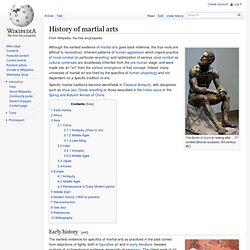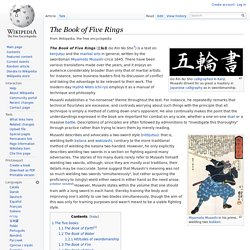

History of martial arts. Although the earliest evidence of martial arts goes back millennia, the true roots are difficult to reconstruct.

Inherent patterns of human aggression which inspire practice of mock combat (in particular wrestling) and optimization of serious close combat as cultural universals are doubtlessly inherited from the pre-human stage, and were made into an "art" from the earliest emergence of that concept. Indeed, many universals of martial art are fixed by the specifics of human physiology and not dependent on a specific tradition or era. Specific martial traditions become identifiable in Classical Antiquity, with disciplines such as shuai jiao, Greek wrestling or those described in the Indian epics or the Spring and Autumn Annals of China.
Early history[edit] Technique 4/10 - Miyamoto Musashi's Niten Ichi Ryu. The Book of Five Rings. The Book of Five Rings (五輪書, Go Rin No Sho?)

Is a text on kenjutsu and the martial arts in general, written by the swordsman Miyamoto Musashi circa 1645. There have been various translations made over the years, and it enjoys an audience considerably broader than only that of martial artists: for instance, some business leaders find its discussion of conflict and taking the advantage to be relevant to their work. The modern-day Hyōhō Niten Ichi-ryū employs it as a manual of technique and philosophy.
Bushido. Japanese samurai in armour, 1860s.

Photograph by Felice Beato Bushidō (武士道?) , literally "samurai's way", is a Japanese word for the way of the samurai life, loosely analogous to the concept of chivalry. Bushido, a modern term rather than a historical one, originates from the samurai moral values, most commonly stressing some combination of frugality, loyalty, martial arts mastery, and honor unto death. Samurai.